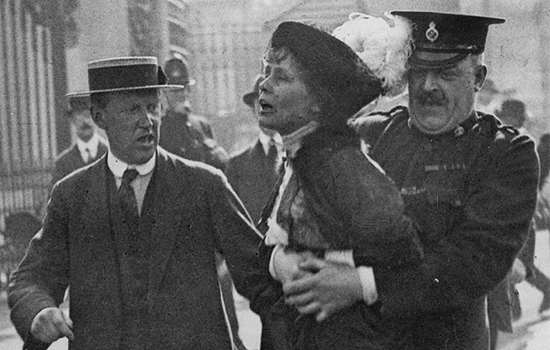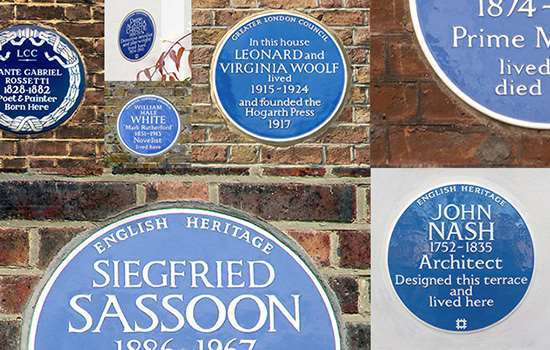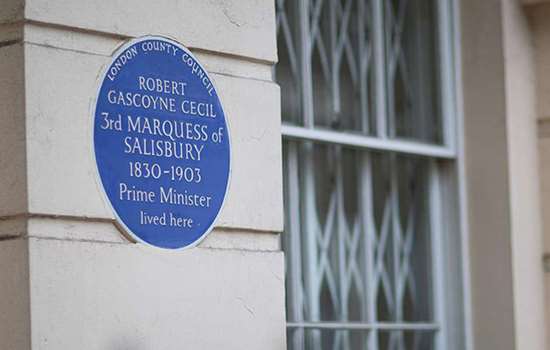BADER, Sir Douglas (1910-1982)
Plaque erected in 2009 by English Heritage at 5 Petersham Mews, Kensington, London, SW7 5NR, Royal Borough of Kensington and Chelsea
All images © English Heritage
Profession
RAF Fighter Pilot
Category
Armed Forces
Inscription
Sir DOUGLAS BADER 1910-1982 RAF Fighter Pilot lived here 1955-1982
Material
Ceramic
Douglas Bader was born in 1910 in north London, the son of Frederick Roberts Bader and Jessie Scott-Mackenzie. The young Douglas spent his early years living with relatives on the Isle of Man whilst his parents were in India – he joined them for a year before they returned to settle in England. In 1923, he won a scholarship to St Edward’s School, Oxford.
Bader’s initial interest in flying was sparked by his aunt’s husband, Cyril Burge, himself an RAF officer. Encouraged by Burge, Bader won a prize scholarship to Cranwell in 1928 – his progression was swift, and after flying solo in 1929, he was commissioned pilot officer a year later. His natural skill earned him a place in the aerobatics team at Hendon but his showmanship caught up with him, and in December 1931, he crashed whilst attempting an ambitious stunt. Though lucky to survive the crash, Bader sustained horrific injuries that necessitated the amputation of both his legs.
Bader adopted an extraordinarily upbeat approach to his disability, and defied the doctor’s expectations by walking with a pair of artificial legs within six months of the crash. He soon set his sights on flying again and he successfully piloted an Avro 504. However, the RAF, faced with such an unprecedented case, decided that Bader could not resume his career as a pilot – he was given ground duties but the naturally flamboyant Bader found this hugely frustrating; he was discharged from the force in 1933. Bader found it difficult to reconcile himself to civilian life and in 1938 – at the height of the Munich crisis – applied to the Air Ministry, but was again refused for re-admittance. He finally extracted a promise that he could return to flying duties once war had been declared and, after completing a refresher course at Cranwell, he reported for duty at RAF Duxford in February 1940. Seven days later he took to the skies in a Spitfire for the first time, a machine he later described as ‘the aeroplane of one’s dreams’.
Rising Through The Ranks
Following promotion in 1940 to Flight Commander in No.222 Squadron, Duxford, he concentrated on honing the handling skills and formation flying of the young pilots under his command. Bader took part in the patrol in support of the evacuation from Dunkirk, and was swiftly promoted to command No. 242 Squadron, made up of battle-weary Canadian pilots bearing the scars of the debacle in northern France. Yet Bader’s enthusiasm and skill moulded the unit into a disciplined fighting team and by August, they joined the battle against the daily German bombing raids. Bader and his commanding officer, Trafford Leigh-Mallory, conceived the plan to deploy five squadrons in a wing formation to attack the German bombers and accompany fighter planes. The ‘Big Wing’ strategy was put into place in two battles on the same day (15 September) – and proved a resounding success. Two days later, Hitler switched to a plan of night-time raids and effectively abandoned any plans to launch an invasion that year. The Battle of Britain had been won.
Bader was promoted to Wing Commander in March 1941 – becoming one of the force’s first ‘Wing Leaders’. He led raiding missions across northern Europe with a view to distracting and destroying German fighter units. By August 1941, Bader could claim that he had shot down twenty-three enemy aircraft, making him the fifth most deadly fighter pilot in the RAF. However, any hope of adding to this tally was dashed on 9 August when Bader collided with a German aeroplane over Bethune and bailed out – leaving one of his prosthetic legs in the cockpit. He was captured by the Germans and after spending a brief spell in hospital, was taken to a prisoner of war camp at Sagan. Bader’s reputation preceded him, and he initially won respect from his captors who arranged for a replacement leg to be parachuted over. Yet Bader’s persistent non co-operation with the Germans and numerous attempts to escape saw him sent to the prison camp at Colditz. There Bader remained until liberation by American troops in 1945.
Accolades and Retirement
Bader was awarded numerous honours for his wartime service, including the Distinguished Service Order and bar, the Distinguished Flying Cross and bar, and the Légion d’honneur. Bader’s reputation was such that he was chosen to lead the first Battle of Britain fly past in September 1945 – a formation of three hundred aircraft.
In peace time, Bader returned to his former employer, Shell Transport and Training, which allowed him to make a number of round-the-world promotional flying trips, accompanied by his wife, Thelma. The publication in 1954 of Paul Brickhill’s biography of Bader, which was made into the popular film Reach for the Sky (1956), brought him widespread fame as a war hero. From 1958 until his retirement in 1969 he was managing director of Shell Aircraft Ltd, but he increasingly devoted time to charitable activities on behalf of the disabled. Bader offered inspiration and practical advice to those living with disabilities and there is little doubt that he helped change attitudes towards those who had suffered the loss of a limb; this pioneering activity is perpetuated by the Douglas Bader Foundation, which was set up by his friends and family, following his death. Bader married Joan, Lady Bader, in 1974, inheriting three step-children and a subsequent family life of in-laws and grandchildren, which he embraced with great enthusiasm and participation. He flew for the last time in 1980 at the age of seventy, and Petersham Mews remained Bader’s London bolt hole until his death in September 1982.
“He literally reached for the sky”
On 31 May 2009, a blue plaque commemorating Sir Douglas was unveiled at 5 Petersham Mews, Royal Borough of Kensington and Chelsea, SW7, where Bader lived for almost 30 years, between 1955 until his death in 1982. Joining the celebration was Sir Richard Branson, a friend of the Bader family and an original supporter of the work of the Douglas Bader Foundation.
Sir Richard Branson said:
“I was very fortunate to have known Douglas Bader as a child since my Aunt Clare was perhaps his best friend. He used to sit on the lawn and tell us stories of how he’d escaped on so many occasions from prisoner of war camps in Germany until the Nazis finally confiscated his legs. Being a 7 year old 'Nasty' myself, I used to run off with his legs to hide them only to find out that he could use his arms just as well as his legs and I never got far! His spirit of adventure had an enormous influence in my life as he had on millions of others. He literally reached for the sky.”
David Bickers, Bader’s son-in-law, Chairman and one of the original founders of the Douglas Bader Foundation, said:
“Douglas was a wonderful step-father, father-in-law and grandfather, resulting in many memorable times at Petersham Mews. His death caused a great hole in our lives and creating the Douglas Bader Foundation has enabled us to continue in his memory his inspiration - providing a wide range of support initiatives and information to the limb loss community.”
Nearby Blue Plaques
More About Blue Plaques



